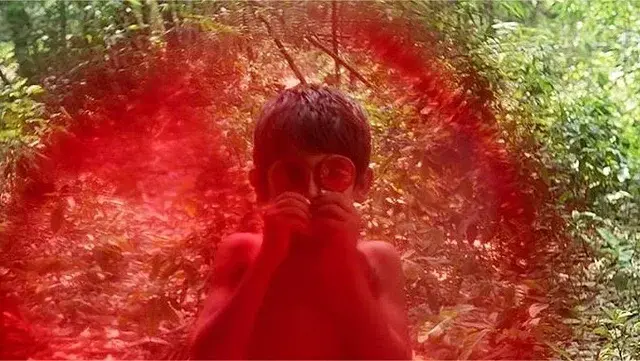There are no rules in experimental cinema other than that the existent ones must be broken or
ignored. Abstraction is hard precisely because there are no guidelines to help one out, and
often abstract films are like a drowning man clutching at straws.
The film is happy to give what little story it has through title cards, reminiscent of the silent era. The rest, emotions, pathos and relevant themes, are conveyed through images, an innovatively crafted background score and cryptic dialogue sprinkled with control for garnish in this masterful recipe.
It starts with a heap of toys being sold on city streets. Cut to a floating shot from a clear sky above a boat, facing the sun directly, coloured blood red. Slowly, the camera pans away from the surreality, and the scene slowly shifts to reveal Daspara. From then on, visuals gaze into the elements that make these toys - bamboo reeds, straws, ropes and, of course, film reels.
One character enigmatically says ‘our stories are forever. We will never run out of stories’. Perhaps it is an artist’s testament to art’s invincibility. It might also be about art breeding art, a cycle as potent as the cycle of life itself.
The film is set against the backdrop of an imminent lunar eclipse. The children in the village look for rubies. Two men ambitiously build a skyscraper like a toy out of their traditional elements in the pursuit of things like a mobile network and a better view of the eclipse. All of them look for purpose, while never quite being able to distance themselves from what they do.
The day of the eclipse arrives, clouds appear. The children search for rubies, the men sit atop their ambitious toy. The film crew religiously shoots. Amidst all of this, art, the omnipresent entity, continues its silent, most natural existence.
Written by Nimish K Sharma
That Cloud Never Left, however, is abstract filmmaking done right. It is subjective enough to allow many interpretations, eerily beautiful enough to catch your eye and structured enough to never wander away from the things it wants to talk about.
Set in the village of Daspara (200 kms from Kolkata) where people make toys to sell in bigger cities for a living, the film follows the day-to-day lives of the people and their innovative toys. They diligently make merry-go-rounds, rattles and flutes with their hands. The toys are cut out of bamboo, straw and old 35mm film reels, after which they are hand-painted. The old reels of Bollywood films are the soul of this surreal film.The film is happy to give what little story it has through title cards, reminiscent of the silent era. The rest, emotions, pathos and relevant themes, are conveyed through images, an innovatively crafted background score and cryptic dialogue sprinkled with control for garnish in this masterful recipe.
It starts with a heap of toys being sold on city streets. Cut to a floating shot from a clear sky above a boat, facing the sun directly, coloured blood red. Slowly, the camera pans away from the surreality, and the scene slowly shifts to reveal Daspara. From then on, visuals gaze into the elements that make these toys - bamboo reeds, straws, ropes and, of course, film reels.
The hypnotising monotony of the work is the norm. This monotonous work makes steady tunes that the sound designer Bigyna Dahal has turned into a brilliant score that works just as well in the film as it does as a standalone piece. It is soothing, euphoric and has a sensibility that ornaments the film.
Film reel dominates the motifs of the film, and also the life in the village. Often dreamlike images that are full of neon colours fill the screen, as if from the chemicals reacting within the reel itself. The existing frames captured in them mingle with the jumble of colours. Like a radio finding frequencies, the reels go back to the station too. Images are projected on closed shop doors. People often watch these films on TV after cutting reels all day, as they listen to old songs. It is as if the films remain as happily effervescent ghosts in the village, their stories mixed in the soil, their soul found in the water of the place.One character enigmatically says ‘our stories are forever. We will never run out of stories’. Perhaps it is an artist’s testament to art’s invincibility. It might also be about art breeding art, a cycle as potent as the cycle of life itself.
The film is set against the backdrop of an imminent lunar eclipse. The children in the village look for rubies. Two men ambitiously build a skyscraper like a toy out of their traditional elements in the pursuit of things like a mobile network and a better view of the eclipse. All of them look for purpose, while never quite being able to distance themselves from what they do.
The day of the eclipse arrives, clouds appear. The children search for rubies, the men sit atop their ambitious toy. The film crew religiously shoots. Amidst all of this, art, the omnipresent entity, continues its silent, most natural existence.
Written by Nimish K Sharma

